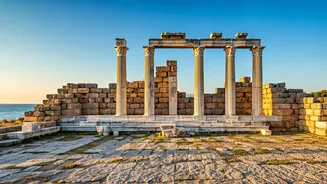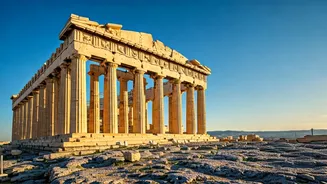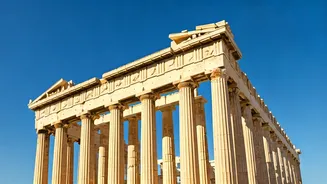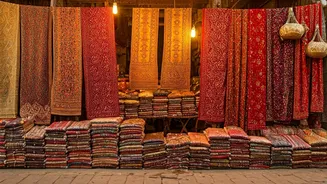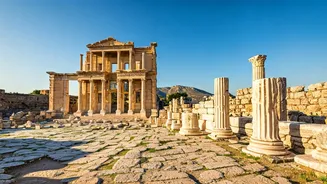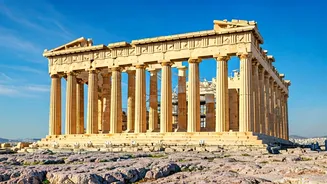Acropolis of Athens
The Acropolis of Athens, crowned by the Parthenon, stands as an unparalleled symbol of ancient Greece and its remarkable architectural and artistic achievements.
Constructed primarily during the 5th century BC, under the guidance of the statesman Pericles, this fortified citadel served as a religious and civic center. The Parthenon, dedicated to the goddess Athena, showcases the brilliance of classical architecture. Its Doric columns, intricate sculptures, and overall symmetry still inspire awe. Beyond the Parthenon, the Acropolis houses other significant structures, including the Propylaea (the monumental gateway), the Erechtheion (with its iconic Caryatids), and the Temple of Athena Nike. Exploring this UNESCO World Heritage site offers insight into the religious beliefs, artistic prowess, and political influence of ancient Athens. The Acropolis’ enduring presence is a testament to the ancient Greeks’ ingenuity and their lasting impact on the world.
Delphi's Sacred Site
Delphi, nestled on the slopes of Mount Parnassus, served as the spiritual center of ancient Greece, primarily known for its oracle. The Sanctuary of Apollo, where the oracle resided, attracted pilgrims from all over the Greek world who sought prophecies and guidance. The ancient Greeks believed that the oracle could communicate with Apollo. The site, besides housing temples and treasuries, featured an impressive theater and stadium, reflecting Delphi's role in the Panhellenic Games. The Castalian Spring, also located at Delphi, was an important spot for ritual purification before visiting the sanctuary. The ruins, nestled in a dramatic landscape, reveal the importance of religion and prophecy in ancient Greek life, and Delphi's historical significance continues to fascinate visitors. The archaeological site provides a vivid picture of the interaction between nature, religion, and human ambition.
Ancient Olympia's Games
The ancient city of Olympia holds immense significance as the birthplace of the Olympic Games. Established in 776 BC, the Games were a religious and athletic festival held in honor of Zeus. The site includes the ruins of the Temple of Zeus, once housing a massive statue of the god, as well as the Temple of Hera, the gymnasium, and the stadium. Athletes from across the Greek world competed in various events, including running, wrestling, and chariot racing. The Games played a vital role in fostering peace and unity among the Greek city-states. Archaeological excavations have uncovered numerous artifacts, revealing the spirit of athletic competition and the cultural context of ancient Olympia. This site is a powerful reminder of the values of sportsmanship, competition, and the unifying power of athletic events.
Knossos Palace, Crete
The Palace of Knossos, located on the island of Crete, is a crucial site for understanding the Minoan civilization. Flourishing from around 2700 to 1450 BC, the Minoans were a highly advanced Bronze Age society. The palace, with its intricate layout, colorful frescoes, and complex drainage systems, exemplifies Minoan architecture and engineering. The labyrinthine structure, featuring numerous rooms, courtyards, and corridors, has fueled the legend of the Minotaur. Archaeological discoveries, including pottery, tools, and art, showcase the Minoans' sophisticated culture, their artistic expressions, and their economic activities. The site's restoration efforts, although sometimes controversial, provide a glimpse into the splendor of Minoan civilization and their place in the early history of the Aegean world. Knossos offers a window into a remarkable civilization, which thrived before the rise of classical Greece.
Ephesus: Roman Glory
Ephesus, a prominent ancient city located in present-day Turkey, flourished under Roman rule. As a major port city and center of commerce, Ephesus was home to impressive structures like the Library of Celsus, the Temple of Artemis (one of the Seven Wonders of the Ancient World), and a grand theater. The library, with its extensive collection of scrolls, was a hub of knowledge and learning. The Temple of Artemis, though only ruins remain, was renowned for its immense size and elaborate decorations. The theater could seat thousands and hosted various performances and events. Ephesus’ well-preserved streets, bathhouses, and public spaces reveal the sophisticated urban planning and daily life of Roman citizens. The city’s history is a testament to its cultural exchange between the East and West. The ruins allow visitors to explore the legacy of Roman civilization and the impact of its imperial power.
Ancient Corinth's Hub
Ancient Corinth, strategically located on the isthmus connecting the Peloponnese to mainland Greece, was a significant center for trade and commerce. The city's strategic location contributed to its economic prosperity. The ruins include the Temple of Apollo, the Agora (marketplace), and various Roman-era structures. Corinth was known for its wealth and its cosmopolitan population. Corinth's position as a major trading hub meant it influenced the exchange of goods and ideas between different parts of the ancient world. The city’s strategic location helped shape its growth, economic power, and cultural influence throughout antiquity. Archaeological excavations continue to reveal the complex interplay of culture, commerce, and political power that defined Corinth's historical significance. The legacy of ancient Corinth helps us understand its impact on the wider Mediterranean world.
Mycenae's Citadel
Mycenae, a powerful Bronze Age city, is renowned for its impressive cyclopean walls and its connection to Greek mythology. The citadel, dating back to the late Bronze Age, was the center of Mycenaean civilization. The Lion Gate, with its iconic relief of two lions, is the primary entrance. Inside the walls, visitors can explore the royal tombs, including the Treasury of Atreus, an impressive structure. Mycenae’s history is intricately linked to the tales of the Trojan War, and the site offers insight into the rise and fall of this significant civilization. The archaeological findings, including elaborate tombs and artifacts, reveal the military might, social organization, and artistic achievements of the Mycenaean people. The ruins of Mycenae allow us to step into the world of heroes and legends, understanding the historical significance of a bygone era.
Delos: Sacred Island
Delos, a small island in the Cyclades, held a sacred status in ancient Greece as the birthplace of the gods Apollo and Artemis. The island flourished as a religious sanctuary and commercial center. The remains include temples, sanctuaries, houses, and a marketplace. The Sanctuary of Apollo was a major pilgrimage site, attracting worshippers from across the Aegean. The Terrace of the Lions, created by the Naxian sculptors, is one of the most famous landmarks on the island. Delos's importance went beyond religious significance; its strategic location made it a thriving trading port. The island showcases the importance of religious belief and the commercial activities within the ancient world. Visitors to Delos can walk among the ruins and explore the connection between history, mythology, and commerce, offering a comprehensive glimpse into ancient Greek life.
